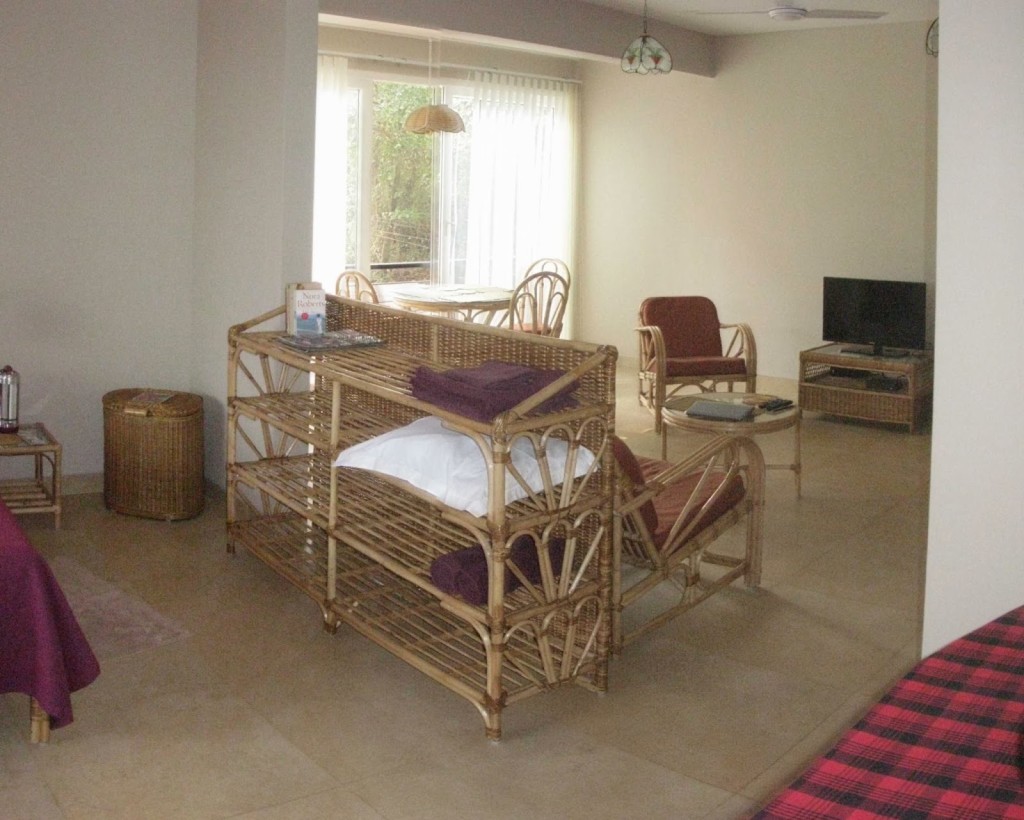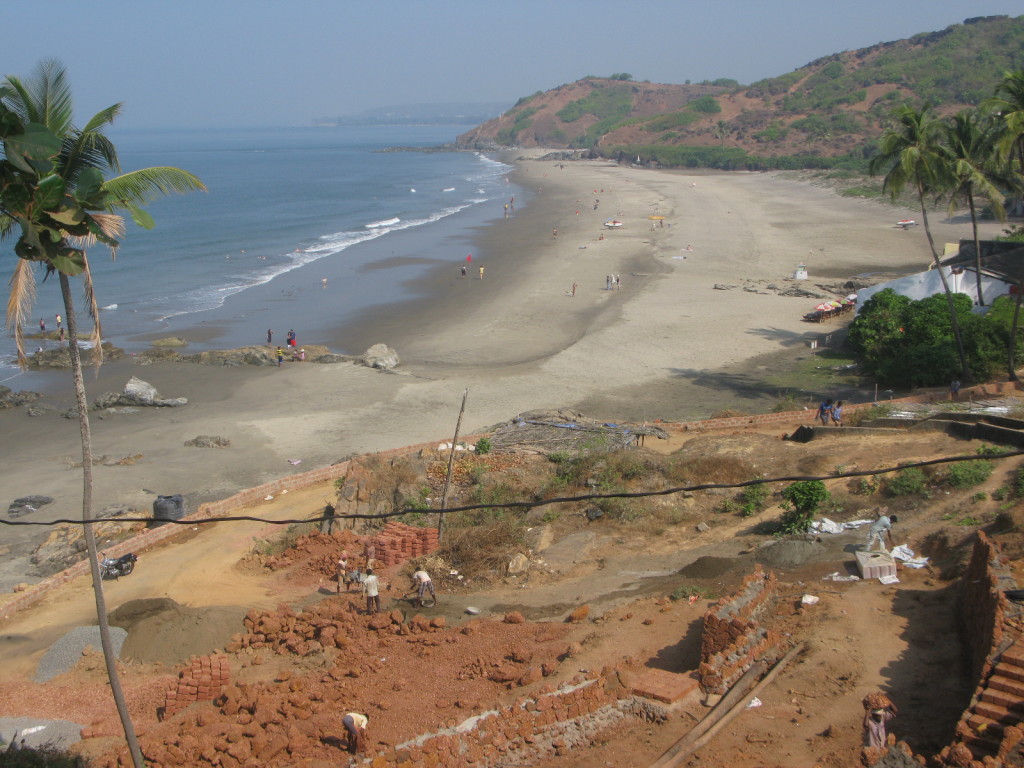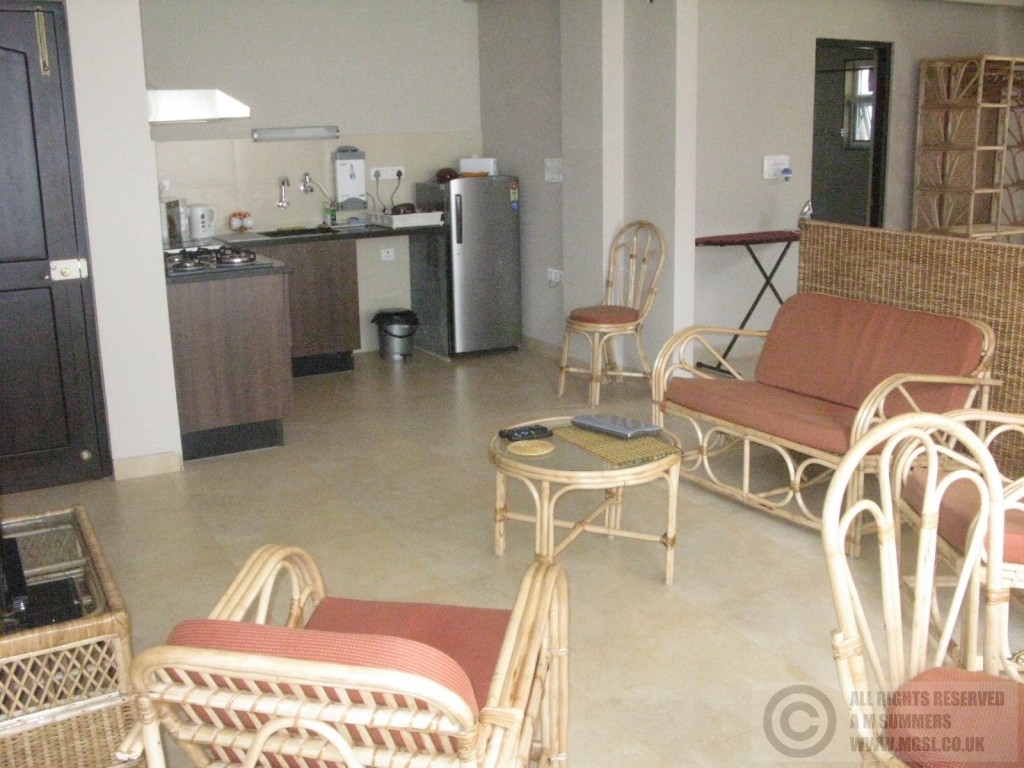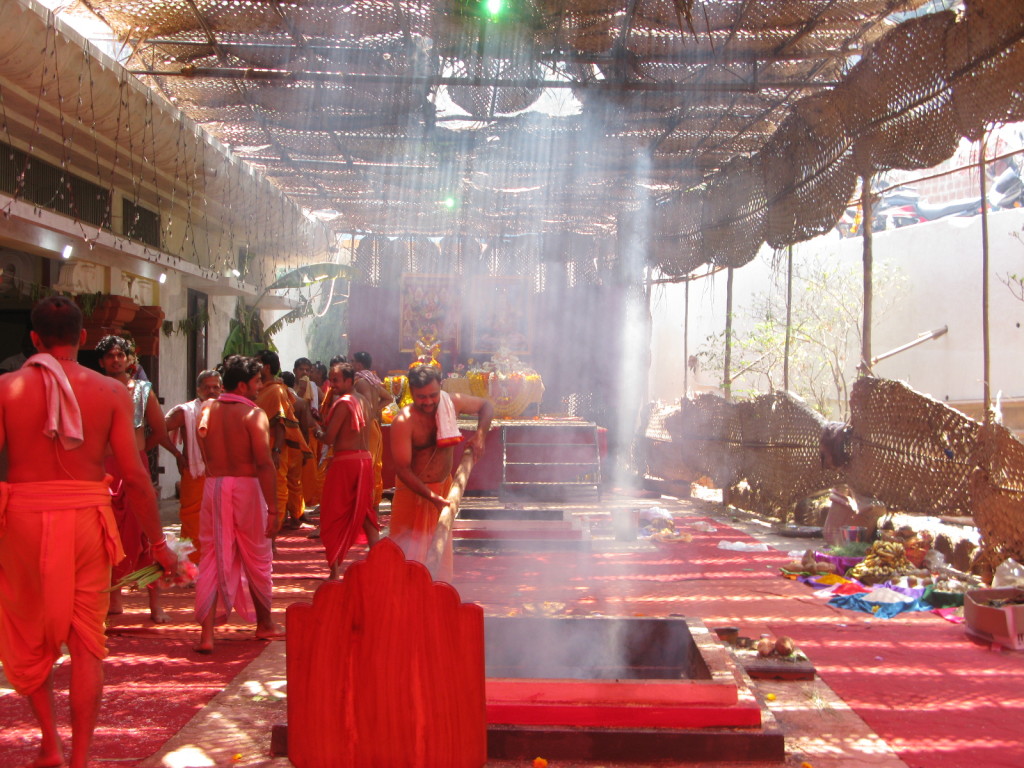
The fabulous rooftop panorama
Half way into our stay, I still can hardly believe our luck in getting this apartment. Before we left Chennai I had fired off emails to the owners of every vacant apartment in the Candolim area that I could find online. We weren’t sure we wanted to be in Candolim, but it sounded as though it might be a reasonable compromise – a not too built up resort, but with a decent choice of rental places, so it seemed a good place to start. I didn’t bother enquiring about properties in Baga or Calangute, knowing their reputations. All the places I emailed were being advertised at a considerably higher rate than the £15 per night that we wanted to spend, but I pointed out that it was be a 2 month occupancy and played up our respectable retired image (ie we won’t trash the place with parties, honest). I said that our budget was around £80 a week, to give a bit of negotiation room. It was a cheeky offer, but I knew that if somewhere wasn’t already booked it was unlikely to get any bookings from abroad now, and other walk-ins like us would know that tourist numbers were well down this season. In any case, we knew that if Candolim didn’t work out we would probably be able to find cheaper places, probably a bungalow, north of Baga or in south Goa.
I didn’t get many replies from the Candolim places, just a couple of ‘sorry, not available’s, although one indicated that the rate was OK if I ever wanted to stay in future and referred me to a friend’s place. But it was no loss, since within a very short time of our arrival in Candolim we had decided that it was not a place in which we wanted to stay – the sand was virtually invisible below the tightly packed rows of sunbeds, and the unbroken line of shacks that lined the beach was blaring out a cacophony of competing beats. The clientele was a mix of youngish Russians and middle aged Brits, all apparently intent on drinking as much as possible and, in the case of the Brits, incessantly and loudly Skyping their friends and families on their mobiles to tell them how much cheap booze they’d managed to consume that day. We left after two nights.
The one apartment outside Candolim about which I’d enquired was in Chapora, which I knew to be a small place that was off the mass tourist radar. There didn’t even seem to be much there in the way of guesthouses, (or at least, not ones with an online presence), so I was a bit surprised to see a very modern holiday apartment there. The owner had replied offering it for £85 per week, so from Candolim we moved to nearby Vagator, which knew from our last trip to India, and arranged to view it. It looked fabulous in the advert, and after a quick reconnaissance walk from Vagator to and around Chapora, we just hoped it was half as nice in reality – it seemed like a real bargain.
It turned out to be as good as it looked. The owners, a Geordie in his early 60s maybe, and a much younger Anglo-Indian woman from Pune, explained that they had only started advertising the apartment the previous week, having completed some alterations (even though it’s a brand new flat) – extending the living room to absorb its balcony (which got too much sun to be usable), and taking out most of the wall between the living room and the bedroom to make it feel more spacious and improve the ventilation. I guess they had placed the advert to get bookings for next season and had not really been expecting guests so soon, because they looked a bit alarmed when we asked if we could move in the following day. We agreed on the day after, to give them time to sort out the finishing touches, which included the provision of a portable induction hob. The advert hadn’t mentioned a cooker, just a microwave, but the photos clearly showed a gas hob – however getting bottled gas here involves numerous bureaucratic hurdles designed to thwart terrorists, and they didn’t have the necessary paperwork proving that they lived at the apartment (which they don’t, of course). As they have also bought the apartment opposite for their own use (for visiting family and to get away from Candolim, where they live), they will probably get gas eventually. For us, the lack of proper cooking facilities would have been a deal-breaker – self-catering was the whole point of getting an apartment. The induction hob only has two rings, but it’s adequate.
 So here we are in a place that is much smarter and better equipped than I had ever hoped. In addition to the hob and microwave, the kitchen has an electric kettle, toaster and fridge with freezer compartment, and a water purifier so that we don’t have to buy gallons of the bottled stuff. The bathroom is ultra modern with a walk-in shower and slate flooring, while the main living area has cream marble floor tiles, trendy cafe au lait walls and cane furniture – 2-seater sofa and 2 chairs, glass topped coffee table, small glass dining table and 4 chairs, TV stand, shelving unit to giving some separation to the bedroom, and a wardrobe. We have Sky TV with a good range of channels in English, and there are 3 ceiling fans – no air conditioning, but the owners plan to install it over the summer. It really isn’t necessary at this time of year, especially now the mosquito screens have been fitted and we can have both sets of French windows open all the time if we want. In fact, we close the bedroom ones at night because it faces the road and it can be a bit noisy. It’s not a major road but it is the main route into the village and there is a lot of motorbike traffic – plus the drivers of elderly buses have to rev to get up the hill, and of course all vehicle sound their horns at frequent intervals, whether they need to or not (India’s transport minister recently announced a campaign against unnecessary horn use – ha!).
So here we are in a place that is much smarter and better equipped than I had ever hoped. In addition to the hob and microwave, the kitchen has an electric kettle, toaster and fridge with freezer compartment, and a water purifier so that we don’t have to buy gallons of the bottled stuff. The bathroom is ultra modern with a walk-in shower and slate flooring, while the main living area has cream marble floor tiles, trendy cafe au lait walls and cane furniture – 2-seater sofa and 2 chairs, glass topped coffee table, small glass dining table and 4 chairs, TV stand, shelving unit to giving some separation to the bedroom, and a wardrobe. We have Sky TV with a good range of channels in English, and there are 3 ceiling fans – no air conditioning, but the owners plan to install it over the summer. It really isn’t necessary at this time of year, especially now the mosquito screens have been fitted and we can have both sets of French windows open all the time if we want. In fact, we close the bedroom ones at night because it faces the road and it can be a bit noisy. It’s not a major road but it is the main route into the village and there is a lot of motorbike traffic – plus the drivers of elderly buses have to rev to get up the hill, and of course all vehicle sound their horns at frequent intervals, whether they need to or not (India’s transport minister recently announced a campaign against unnecessary horn use – ha!).
Being on the 2nd floor the immediate outlook from the bedroom balcony is of mango and jackfruit branches which are visited by crows and an extremely vocal bird called a koel which specialises in 5am calls. Below is the flat roof of the bungalow that stands between the apartment block and the road, favoured haunt of a black and white cat and playground for chipmunks (also vocal – they can sound like a squeaky wheel). Opposite is a junior school – not very large, perhaps three classrooms and no more than 30 pupils. Next to that is Chapora’s main temple – after the traffic and the dogs and the koel it’s the main source of noise, especially on a Monday when it’s apparently necessary to ring the bell in the shrine for about half an hour at 5:30am. The chanting, table playing and random bursts of firecrackers at least tend to occur during the day, as do the arrivals of wedding parties in speaker-topped cars playing the music that traditionally would be provided by a brass and drum band.
There is another, smaller apartment block next door which is part of the same complex and provides a bit of shade for the south facing living room which looks out over the courtyard and gate, and beyond that the neighbouring Humming Wood hotel (also new). Unless we are standing by either of the French windows we can’t be seen from outside, but for much of the day we keep the living room blinds closed against the sun.
We make an effort to keep the place spick and span – when the kitchen, living room and bedroom are all open plan you can’t just close the door and ignore the mess, so the bed gets made far more promptly than it ever did at home. With only a limited supply of crockery and cutlery, washing up has to be done frequently anyway. There’s no hot water plumbed in to the kitchen, so we bought a little bucket to carry it from the bathroom, where there’s an electric geyser. At first I thought it was bizarre for a modern apartment not to have hot water in the kitchen, but with the bathroom so close it’s really not necessary. No washing machine, so laundry is done in a bucket in the shower, as it has been ever since we arrived in India (ignoring hotel notices prohibiting such activity). At least here we have a balcony complete with a rack on which to dry our washing, even if it does face east and gets little direct sun.
Clean sheets and towels are supplied once a week but, being new at this, I think our landlady has forgotten that clean tea towels are also important – but since we are paying less than half the advertised rent it seems churlish to complain, so we wash them ourselves. Every Wednesday morning our landlady, Giselle, brings her own maid on a scooter from Candolim to change the bed and clean the flat. Originally it was suggested that she come on Saturdays as well, but it really didn’t seem necessary. We keep the kitchen tops and the hob clean, and sweep the floor every day with what Al calls a floor whisk (a very effective hand broom made of coarse grass), so mainly all that’s required on Wenesdays is a thorough mopping. We don’t, of course, wear shoes indoors, so it doesn’t get very dirty. It’s not just that we’re excessively house proud – crumbs, spills and unwashed crockery encourage ants. We did have an invasion of tiny sugar ants coming in through the tiniest wall cracks, but ant powder saw them off within a couple of days.
The other reason for keeping on top of the washing up and the laundry is that we never know when the water or the power will go off. The block has a back-up tank for when the piped supply fails, but it can take an hour or more for the pump to get up enough pressure, and we have no idea how long the tank supply will last if there is a prolonged interruption, so we keep the bathroom bucket full, and always refill the kettle and drinking water bottles promptly. I guess the water has gone off four times in the last three weeks.
Power cuts are more frequent, perhaps every other day, and can be for just a few minutes (temporary fault) to about an hour (evening load-shedding at around 7pm) to all day (repairs to the network – a 9am power cut is the most ominous). The cuts haven’t caused us any great problems, but we did have to go out for breakfast one day – they do make us a little wary of using the lift, although the complex does have a generator for the common areas so we wouldn’t be stuck for long. We just have to make sure that we keep all our electronic stuff charged up, as well as the storm lantern.
The crowning glory of this place is on the roof – an infinity swimming pool with almost panoramic views, from the ridge of Vagator to the south west, a dip with the sea beyond, the red ruins of Chapora fort atop its hill, to the north the mouth of the Chapora river marked by a line of breaking surf and the wide beach of Morjim beyond, the fishing boats in Chapora on this shore, the wide river with its tidal flats that look like streaks of snow until the seagulls take flight, distant hills that appear and disappear through haze, and then the near ridge of Badem to the east with the steep uninhabited hill that separates us from Siolim beyond it. Apart from the fort and the river, all is green, just a few teracotta roofs, pastel walls and flashes of bright blue tarpaulin peeking through the trees – waving coconuts hide most of the other trees on the low land of the village centre, while mango, jackfruit, cashew and cassia dominate the hillsides. Far off near the harbour is the distinctive spreading canopy of a large banyan. Only the area immediately below the fort is bare of trees, just brown grass and scrubby bushes. With the constant breeze, it feels like being at the prow of a ship in an undulating green sea. Five stories up, wheedling kites sometimes pass only a few feet above, and we look down on green parakeets and other birds as they fly between the trees. Crows and wagtails land at the edge of the pool to drink, while swallows swoop down to sip on the wing. All in all, not a bad place to sit with a G & T as the sun goes down. More importantly, after 3 months of hotel rooms and restaurant dining we have a home for a couple of months – a nice break before the travelling starts again.







